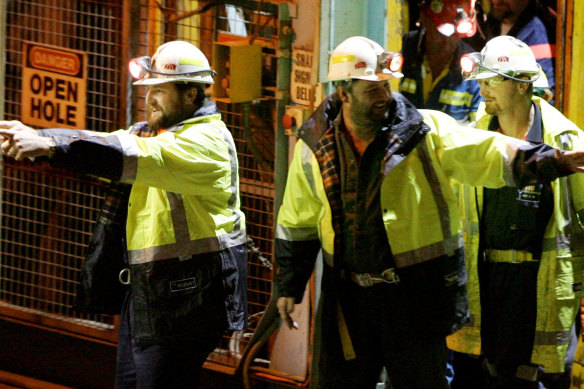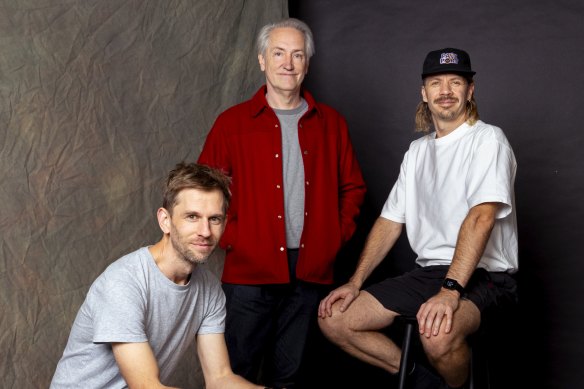
With the tsunami episode, for example, there are reflections from a number of people caught up in the disaster: tourists on eagerly anticipated holidays, others who’d impulsively opted for a mini-break at a Thai resort, a local business owner who was visiting for meetings. It’s the familiar stuff of everyday life, after which people find themselves propelled into situations that they could never have imagined.
In addition to being a strong concept featuring a smart selection of subjects, IWAT is enhanced by its execution: a judicious choice of contributors, the polished staging of interviews, the fluidity with which accounts are woven together and the sparing but evocative use of archival footage. Through the mosaic of perspectives, events that might previously have seemed exhaustively documented feel fresh and alive.

Todd Russell (left) and Brant Webb emerge from the Beaconsfield mine after their rescue.Credit: Getty
The episodes have a straightforward chronological structure. A concise introduction provides context, using archival footage to set the scene. It’s followed by accounts of how events unfolded, consideration of their impact, and reflections on the aftermath. As with YCAT, a house style is established. Here, people sit in front of a grey-green canvas backdrop that somehow manages to be classy and oddly calming.
The interviewees aren’t identified by on-screen titles, although they’re all listed in the end credits. That choice, eschewing the familiar news and current-affairs style, makes this production seem more intimate: the testimonies feel more direct and personal. It also democratises the process: all the contributors are equally valid and equally valuable.
In the Port Arthur episode, a chef at The Broad Arrow Cafe, a police sniper, a local GP and victims of the shooting all appear, their roles in the attack emerging through their accounts of what they saw, did and felt. And you might think that you know a lot about the Tasmanian mine disaster and the almost-miraculous rescue of miners Todd Russell and Brant Webb after 321 hours trapped under 12 metres of rock. But here, as well as hearing from the men about their horrifying ordeal, you hear from mine managers, family members, townsfolk, journalists and members of the rescue team.

I Was Actually There co-creators (from left) Aaron Smith, Jon Casimir and Kirk Docker, in front of their bespoke backdrop.Credit: Dominic Lorrimer
As a result, the series is rich with the kind of impressionistic detail that makes this version of history so compelling. On the scene in Port Arthur as mass-murderer Martin Bryant runs semi-naked from a burning house, police sniper Craig Harwood, who subdued the killer with mace spray, recalls: “He had very blue eyes. You understand a lot about a character when you look into someone’s eyes. He had blue marbles, you just stare straight through them: nothing.” From a man who appears unflappable and accustomed to dealing with danger, the observation is telling and chilling.
Loading
Docker is a gifted storyteller and, with his collaborators, he’s again created something special. But in addition to its value as a documentary, IWAT demonstrates the ABC’s critical role as a training ground. Docker and Smith are among the fledgling talents that emerged from Hungry Beast, along with Marc Fennell, Dan Ilic and Kirsten Drysdale. Before it came Attitude (1993-95), an energetic and innovative current-affairs show also focused on nurturing new talent. In addition to introducing Aaron Pedersen, who was at that stage training as a journalist, it provided an early foothold in the industry and invaluable experience for a host of journalists and producers who went on to helm shows including Australian Story, Back Roads and Insight.
Over the years, many avenues for hands-on training have disappeared. And, given the current, shaky state of the TV industry and its predominantly casualised workforce, it’s more important than ever that the ABC fills that gap. As this standout series attests, the rewards for the broadcaster and the viewing public are substantial.
Find out the next TV, streaming series and movies to add to your must-sees. Get The Watchlist delivered every Thursday.









 Add Category
Add Category